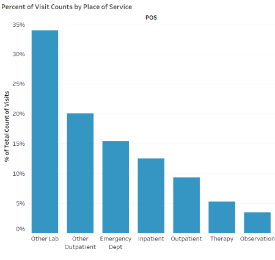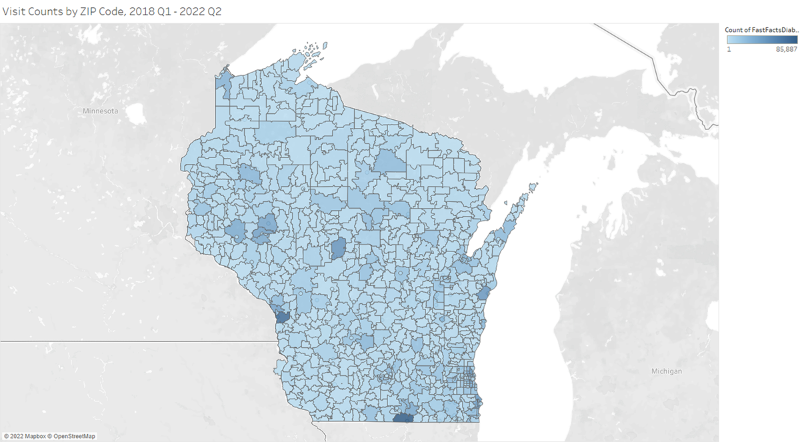Vol. 66, Issue 44
View more issues of The Valued Voice
Sign Up for WHA's Newsletter
Click here to view past issues
IN THIS ISSUE
- Speaker Robin Vos: WHA’s Advocacy “Never More Important Than This Next Session”
- New Leaders Elected to WHA Board of Directors
- Reminder: Vote on Tuesday, November 8
- Exchange Open Enrollment Begins for 2023 Benefit Year
- CMS Raises Hospital Payments Slightly in Final 2023 OPPS Rule
- Join a WHA Council or Committee
- Stuessy Named WHA Education Coordinator
- AHA Calls for Action to Reduce Inappropriate Prior Authorization and Payment Delays
- Hospitals Keep Communities Healthy
- WHA’s Social Determinants of Health Webinar Series: A Journey to a Healthier Wisconsin Webinar 4 Recap
- Ascension Mercy Hospital and Project SEARCH Awarded 2022 Global Vision Community Partnership Award
- November Fast Facts: National Diabetes Month
EDUCATION EVENTS
Jan. 14, 2026
Caring for Wisconsin’s Caregivers Well-Being First Champion Challenge for Credentialing KickoffJan. 28, 2026
2026 WHA Health Care Leadership AcademyFeb. 10, 2026
Age-Friendly Webinar Series Featuring Advocate HealthClick here to view education event calendar
View more issues of The Valued Voice
Sign Up for WHA's Newsletter
Thursday, November 3, 2022
 The World Health Organization cites that 422 million people worldwide have diabetes—approximately one in every 11 people. In the United States, the Centers for Disease Control and Prevention found that more than 37 million people have diabetes, yet one in five of those people are not aware they have it. When looking at prediabetics in the U.S., the numbers jump even higher with 96 million adults having prediabetes—over a third of the population of the country. Diabetes is the seventh leading cause of death in the U.S. Within the last 20 years, the number of adults with diabetes has more than doubled. People with Type 2 diabetes account for roughly 90 to 95% of all diagnosed diabetes cases. November is known as National Diabetes Month to bring attention and education to people about diabetes and support for those who are diagnosed.
The World Health Organization cites that 422 million people worldwide have diabetes—approximately one in every 11 people. In the United States, the Centers for Disease Control and Prevention found that more than 37 million people have diabetes, yet one in five of those people are not aware they have it. When looking at prediabetics in the U.S., the numbers jump even higher with 96 million adults having prediabetes—over a third of the population of the country. Diabetes is the seventh leading cause of death in the U.S. Within the last 20 years, the number of adults with diabetes has more than doubled. People with Type 2 diabetes account for roughly 90 to 95% of all diagnosed diabetes cases. November is known as National Diabetes Month to bring attention and education to people about diabetes and support for those who are diagnosed.
 The WHA Information Center analyzed Type 1 and 2 diabetes visits from all places of service for the timeframe 2018 Q1 to 2022 Q2. When analyzing gender, it was almost split even for visit counts with men at 52% of all visits and women at 48%. The highest ZIP code with diabetes-related visits is located in Rock County, followed closely by a ZIP code in La Crosse County. When analyzing pay type, the average age of patients for a diabetes related visit is 64 years old which supports that Medicare patients have the highest visit counts. The place of service with the highest visit counts is other lab services followed by other outpatient visits and the emergency department.
The WHA Information Center analyzed Type 1 and 2 diabetes visits from all places of service for the timeframe 2018 Q1 to 2022 Q2. When analyzing gender, it was almost split even for visit counts with men at 52% of all visits and women at 48%. The highest ZIP code with diabetes-related visits is located in Rock County, followed closely by a ZIP code in La Crosse County. When analyzing pay type, the average age of patients for a diabetes related visit is 64 years old which supports that Medicare patients have the highest visit counts. The place of service with the highest visit counts is other lab services followed by other outpatient visits and the emergency department.

Below are some ways that you can get involved with Diabetes Awareness Month from the American Diabetes Association:
November Fast Facts: National Diabetes Month
 The World Health Organization cites that 422 million people worldwide have diabetes—approximately one in every 11 people. In the United States, the Centers for Disease Control and Prevention found that more than 37 million people have diabetes, yet one in five of those people are not aware they have it. When looking at prediabetics in the U.S., the numbers jump even higher with 96 million adults having prediabetes—over a third of the population of the country. Diabetes is the seventh leading cause of death in the U.S. Within the last 20 years, the number of adults with diabetes has more than doubled. People with Type 2 diabetes account for roughly 90 to 95% of all diagnosed diabetes cases. November is known as National Diabetes Month to bring attention and education to people about diabetes and support for those who are diagnosed.
The World Health Organization cites that 422 million people worldwide have diabetes—approximately one in every 11 people. In the United States, the Centers for Disease Control and Prevention found that more than 37 million people have diabetes, yet one in five of those people are not aware they have it. When looking at prediabetics in the U.S., the numbers jump even higher with 96 million adults having prediabetes—over a third of the population of the country. Diabetes is the seventh leading cause of death in the U.S. Within the last 20 years, the number of adults with diabetes has more than doubled. People with Type 2 diabetes account for roughly 90 to 95% of all diagnosed diabetes cases. November is known as National Diabetes Month to bring attention and education to people about diabetes and support for those who are diagnosed. The WHA Information Center analyzed Type 1 and 2 diabetes visits from all places of service for the timeframe 2018 Q1 to 2022 Q2. When analyzing gender, it was almost split even for visit counts with men at 52% of all visits and women at 48%. The highest ZIP code with diabetes-related visits is located in Rock County, followed closely by a ZIP code in La Crosse County. When analyzing pay type, the average age of patients for a diabetes related visit is 64 years old which supports that Medicare patients have the highest visit counts. The place of service with the highest visit counts is other lab services followed by other outpatient visits and the emergency department.
The WHA Information Center analyzed Type 1 and 2 diabetes visits from all places of service for the timeframe 2018 Q1 to 2022 Q2. When analyzing gender, it was almost split even for visit counts with men at 52% of all visits and women at 48%. The highest ZIP code with diabetes-related visits is located in Rock County, followed closely by a ZIP code in La Crosse County. When analyzing pay type, the average age of patients for a diabetes related visit is 64 years old which supports that Medicare patients have the highest visit counts. The place of service with the highest visit counts is other lab services followed by other outpatient visits and the emergency department.
Below are some ways that you can get involved with Diabetes Awareness Month from the American Diabetes Association:
- Help raise awareness: Some examples of events to participate in include The Tour de Cure and Step Out: Walk to Stop Diabetes.
- Donate to support research: Through the American Diabetes Association, there are donation options including monthly donations, corporate giving or your own fundraiser.
- Volunteer at an event: Find the spot that works best for you, whether it’s supporting an event, working at a local office, taking part in a school or community campaign or becoming a virtual volunteer.
Vol. 66, Issue 44
Thursday, November 3, 2022
November Fast Facts: National Diabetes Month
 The World Health Organization cites that 422 million people worldwide have diabetes—approximately one in every 11 people. In the United States, the Centers for Disease Control and Prevention found that more than 37 million people have diabetes, yet one in five of those people are not aware they have it. When looking at prediabetics in the U.S., the numbers jump even higher with 96 million adults having prediabetes—over a third of the population of the country. Diabetes is the seventh leading cause of death in the U.S. Within the last 20 years, the number of adults with diabetes has more than doubled. People with Type 2 diabetes account for roughly 90 to 95% of all diagnosed diabetes cases. November is known as National Diabetes Month to bring attention and education to people about diabetes and support for those who are diagnosed.
The World Health Organization cites that 422 million people worldwide have diabetes—approximately one in every 11 people. In the United States, the Centers for Disease Control and Prevention found that more than 37 million people have diabetes, yet one in five of those people are not aware they have it. When looking at prediabetics in the U.S., the numbers jump even higher with 96 million adults having prediabetes—over a third of the population of the country. Diabetes is the seventh leading cause of death in the U.S. Within the last 20 years, the number of adults with diabetes has more than doubled. People with Type 2 diabetes account for roughly 90 to 95% of all diagnosed diabetes cases. November is known as National Diabetes Month to bring attention and education to people about diabetes and support for those who are diagnosed. The WHA Information Center analyzed Type 1 and 2 diabetes visits from all places of service for the timeframe 2018 Q1 to 2022 Q2. When analyzing gender, it was almost split even for visit counts with men at 52% of all visits and women at 48%. The highest ZIP code with diabetes-related visits is located in Rock County, followed closely by a ZIP code in La Crosse County. When analyzing pay type, the average age of patients for a diabetes related visit is 64 years old which supports that Medicare patients have the highest visit counts. The place of service with the highest visit counts is other lab services followed by other outpatient visits and the emergency department.
The WHA Information Center analyzed Type 1 and 2 diabetes visits from all places of service for the timeframe 2018 Q1 to 2022 Q2. When analyzing gender, it was almost split even for visit counts with men at 52% of all visits and women at 48%. The highest ZIP code with diabetes-related visits is located in Rock County, followed closely by a ZIP code in La Crosse County. When analyzing pay type, the average age of patients for a diabetes related visit is 64 years old which supports that Medicare patients have the highest visit counts. The place of service with the highest visit counts is other lab services followed by other outpatient visits and the emergency department.
Below are some ways that you can get involved with Diabetes Awareness Month from the American Diabetes Association:
- Help raise awareness: Some examples of events to participate in include The Tour de Cure and Step Out: Walk to Stop Diabetes.
- Donate to support research: Through the American Diabetes Association, there are donation options including monthly donations, corporate giving or your own fundraiser.
- Volunteer at an event: Find the spot that works best for you, whether it’s supporting an event, working at a local office, taking part in a school or community campaign or becoming a virtual volunteer.
IN THIS ISSUE
- Speaker Robin Vos: WHA’s Advocacy “Never More Important Than This Next Session”
- New Leaders Elected to WHA Board of Directors
- Reminder: Vote on Tuesday, November 8
- Exchange Open Enrollment Begins for 2023 Benefit Year
- CMS Raises Hospital Payments Slightly in Final 2023 OPPS Rule
- Join a WHA Council or Committee
- Stuessy Named WHA Education Coordinator
- AHA Calls for Action to Reduce Inappropriate Prior Authorization and Payment Delays
- Hospitals Keep Communities Healthy
- WHA’s Social Determinants of Health Webinar Series: A Journey to a Healthier Wisconsin Webinar 4 Recap
- Ascension Mercy Hospital and Project SEARCH Awarded 2022 Global Vision Community Partnership Award
- November Fast Facts: National Diabetes Month

